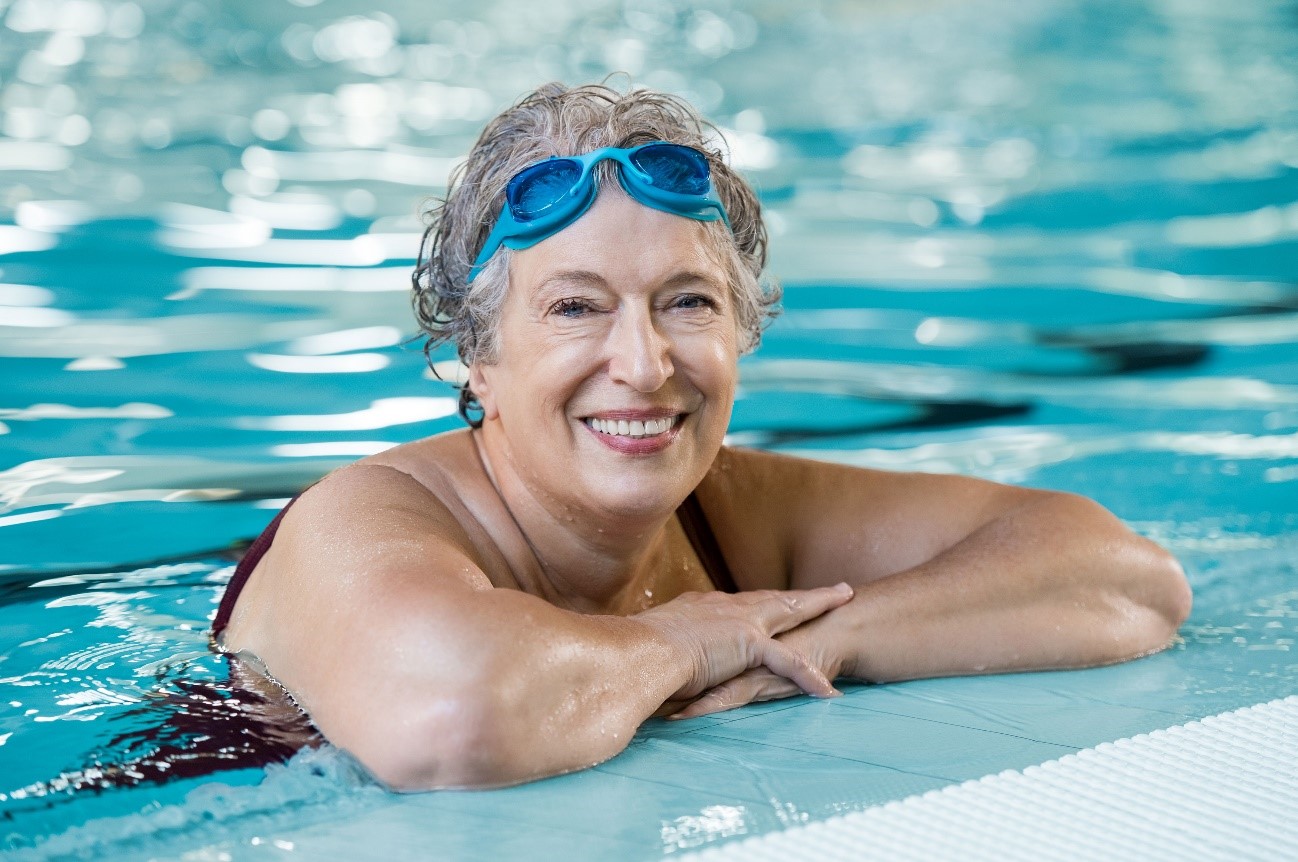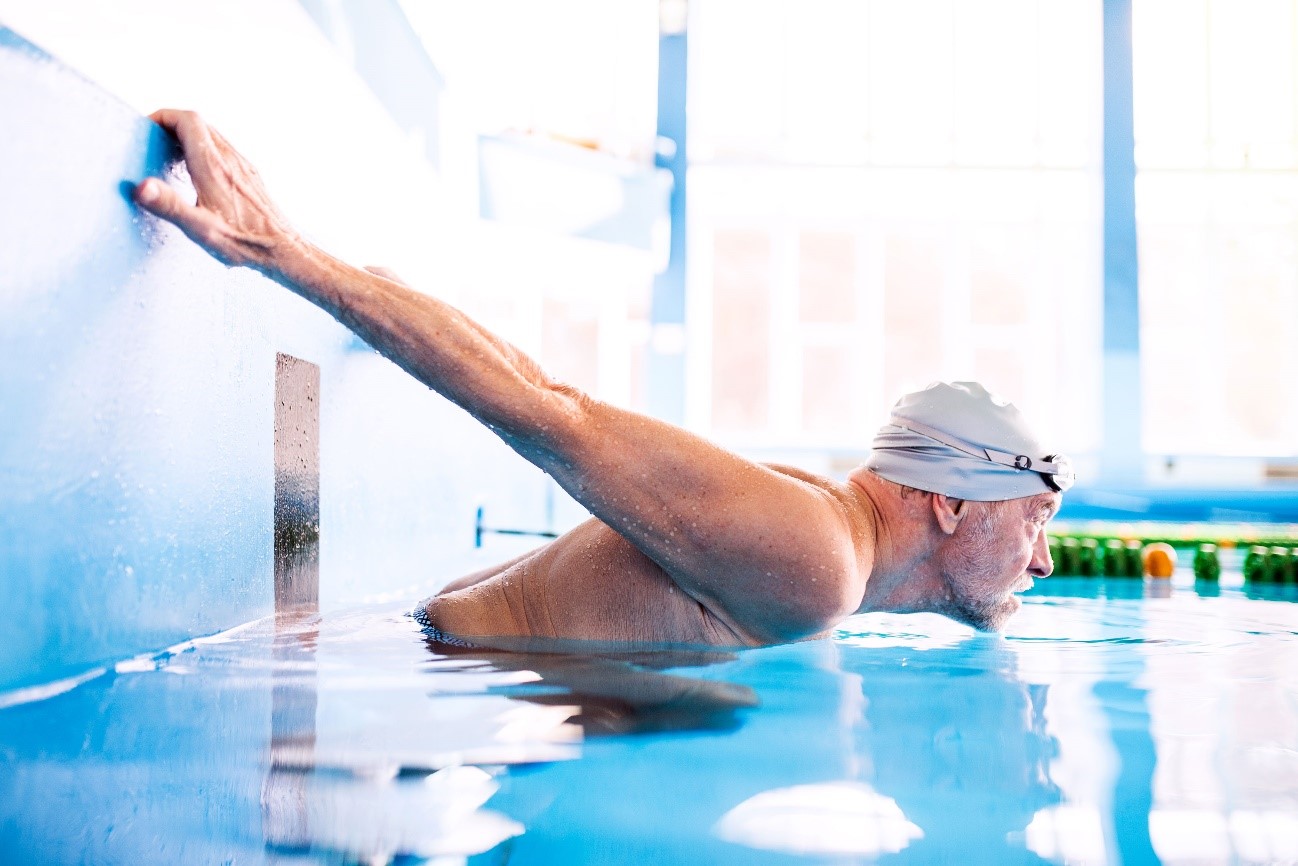How can swimming improve balance?
Swimming and water aerobics are the best forms of exercise to improve balance, help strengthen muscles and improve bone density
Written by Stannah
We’ve all heard about how a sedentary lifestyle increases your risk of developing life-threatening health conditions such as heart disease, diabetes and cancer. However, we really don’t hear much about how important it is to improve our sense of balance and how doing so can go a long way in fall prevention, especially as we grow older. A recent study proved swimming and water exercises are the best forms of exercise to improve balance. This may not come as a surprise, as we all know swimming has mental and physical benefits, but according to this study, swimming is the best form of exercise for a senior to easily boost their physical condition and can directly contribute to improving their sense of balance. Swimming can also help reduce discomfort from a previous fall, but most importantly, it can reduce the risk of falling at all. Read on to find out how!

To start with, let’s consider water safety. If you are unable to swim without help, you should not swim alone. We highly recommend a buddy system, where you always swim with your swimming buddy – even if you’re both great swimmers. A caregiver can provide safety for the senior by assisting them with getting in and out of the pool and walking with them on wet, slippery surfaces. Having someone go with you can help you enjoy the benefits of swimming without worrying about any dangers. As long as safety is made a priority, you’re good to go!
Swimming and water exercises: why is it the best exercise for older adults?
For many years now, common sense has told us that swimming is a beneficial exercise, but several studies have finally proved it. A study published in the American Journal of Epidemiology, for instance, states that swimming and water exercises can be the best form of exercise to help seniors lower their risk of falling, thanks to how it improves balance and strengthens core muscles. This new study is the first to compare several types of physical activity to find out which is the most beneficial in preventing falls. Concern around improving balance has increased as falls and injuries in older people are becoming major public health issues and a lot of the time, falls could result in death for older adults. Falls happen more frequently than we might imagine, and in situations we might not expect, for example during leisure time or even during housework. Raising awareness of this issue is never going to be enough to get everybody moving and improving their balance – we need action! And swimming is the perfect form of exercise because it doesn’t strain muscles and joints the same way as strength training would. Learn more about how swimming or water exercises can increase strength and flexibility.
Why is functional walking not enough?
For older adults who have been cleared to engage in moderate exercise by their doctor, swimming is the perfect way to improve strength in their core and lower body. However, many older adults are limited in the physical activity they can do. Some resort to functional walking, but that is not enough to actually strengthen their core muscles and improve balance. Swimming develops strong, stable core muscles, which are necessary for good balance — a major factor in fall prevention. Unlike functional walking, swimming is considered a more complex motor activity. Water is approximately twelve times denser than air. So, even if you can’t swim, water jogging or water walking provides you with way more resistance, without you even noticing it, as the body only carries 50 percent of its weight. And if you’re immersed in water all the way up to your neck, you only have to support 10 percent of your own weight. The faster you go, the more the water resists and builds up your muscle strength. Swimming and water exercises are also the quickest way to improve neuromuscular response after an injury, for example.
Unlike many other forms of exercise, the low impact nature of swimming presents minimal risk of injury, making it an ideal choice for older adults who wish to stay in shape and maintain their physical and psychological health.
How does swimming improve balance?
“Balance training is the most efficacious exercise to prevent falls”
Meron D., et al.
It has been scientifically proven (in the study mentioned above) that seniors who swim have 33% less chance of falling than those who don’t do any water exercise. They showed less “postural sway”, meaning they were able to stand stronger without movement in their hips.

Swimming contributes to muscle strengthening
What is it about water and swimming that can be so beneficial to our body? As one ages, muscle loss occurs, which leads to decreased strength. Therefore, as water provides resistance, it can be beneficial to strength building – it can lead to the same results as weight training exercises but without straining muscles and joints. Also, swimming works more muscles at once, therefore preventing muscle loss in almost every muscle of our bodies including the most important muscle in our bodies: our heart. Swimming also increases our cardiovascular functional capacity, which means our heart is more capable of pumping blood efficiently.
Water aerobics reduce risk of osteoporosis
Water aerobics classes are also a fun way to get into the pool and exercise, while also providing social interaction – a benefit we talked about previously.
One of the changes to the human body that many seniors struggle with is linked to bone density. Women are at greater risk for osteoporosis, and activities like swimming can reduce that risk by enhancing bone marrow density. Water aerobics is a good example of an activity that helps do this, and people enjoy it a lot as it usually entails water walking, dancing and other aerobic exercises that resemble classes on dry land.

Benefits of swimming to improve flexibility
Water exercises give the elderly a way to get in better shape without putting added stress or strain on the body. Swimming involves multiple muscles moving simultaneously, and since you need an extensive range of motion, it allows the joints to become loose and flexible, which is vital for balance. It can help to reduce back pain, enhance muscle coordination, decrease soreness, and improve posture. Maintaining flexibility can also help prevent injury. Swimming in a warmer pool will naturally relax the muscles and stimulate blood circulation, reducing stress on the body and allowing your joints to move with ease. The support of the water should help you maintain positions involving tricky balance — such as a quad stretch — for longer periods of time.

Our sense of balance is often taken for granted and we might not even notice a balance issue until we start stumbling – and for older adults, the risk of falling should be a major concern. Broken bones, head trauma or even smaller injuries can seriously affect mobility and quality of life, so it is worth investing in your sense of balance before it becomes a problem.
If you’re looking for a way to exercise without the pain and strain of a regular gym workout, swimming is a great alternative. However, as with any new exercise routine, make sure you consult your doctor before you start. A 20-minute swimming session at least 3 times a week can make a significant difference in your overall health and wellbeing. Swimming provides many of the same benefits as yoga or Tai chi, as it decreases muscular tension and helps promote relaxation, which can be particularly beneficial if you have trouble maintaining a regular sleep pattern. And if it’s been a while since you’ve been in a pool, don’t let that stop you! Enjoy the wide range of benefits swimming has to offer and remember that you’re never too old to start!
Sources:
- Merom D, Stanaway F, Handelsman D, Waite L, Seibel M, et al. Swimming and Other Sporting Activities and the Rate of Falls in Older Men: Longitudinal Findings From the Concord Health and Ageing in Men Project. American Journal of Epidemiology.
- Rowan K. Why Swimming May Be the Best Exercise for Older Adults, Health Editor, Live Science
Further reading
5 Reasons to Conquer Ageing with Yoga
Loss of balance, what you need to know about your body’s balance health
Laughter is the best medicine
